The innovations in China's primary health care reform: Development and characteristics of the community health services in Hangzhou
Feng Lin, Qihong Sun, Zhangping Peng, Jun Cai, Philip Geanacopoulos, Lin Li, Yun Zhao, Xin Zhang,Xiaoxiao Chen
1. ACON Primary Care Research Center, 4F Tower B, Union Plaza,No.2 Zijinghua Road, Hangzhou,Zhejiang 310023, China
2. Walter H. Shorenstein Asia-Pacific Research Center,Freeman Spogli Institute for International Studies, Stanford University, 616 Serra St., Encina Hall E311, Stanford, CA 94305,USA
The innovations in China's primary health care reform: Development and characteristics of the community health services in Hangzhou
Feng Lin1,2, Qihong Sun1, Zhangping Peng1, Jun Cai1, Philip Geanacopoulos1, Lin Li1, Yun Zhao1, Xin Zhang1,Xiaoxiao Chen1
1. ACON Primary Care Research Center, 4F Tower B, Union Plaza,No.2 Zijinghua Road, Hangzhou,Zhejiang 310023, China
2. Walter H. Shorenstein Asia-Pacific Research Center,Freeman Spogli Institute for International Studies, Stanford University, 616 Serra St., Encina Hall E311, Stanford, CA 94305,USA
Objective:This study focuses on Hangzhou, a Chinese city with a population of nine million urban and rural residents, to examine the successful development and innovation experience of its primary health care service system during the new health reform in China since 2009 and then disseminate the findings through international third parties.
Methods:Measures such as data analysis, study of documents and regulations, fieldwork, and expert discussions were used to systematically investigate primary health care in Hangzhou. The findings will have a profound practical impact on the health reform for nine million rural and urban residents throughout Hangzhou's municipal boroughs.
Results:Community health services in Hangzhou are characterized as follows: They are government led; they are guaranteed with enough financing, personnel, facilities, and regulation; supported by the unified information platform; general practitioners have been assigned the key role of health 'gatekeepers'; they provide primary care combined with basic public health services; there are integrated urban and rural health services and insurance coverage; and there is health care–pension–nursing integration and general practitioner – contracted 'smart' services. Preliminary data collection and analysis indicate that the basic health status of Hangzhou residents is superior to that of residents of China as a whole, and some health indicators in Hangzhou are comparable to those in Western developed countries.
Conclusion:It is reasonable to believe that the primary health care level in China, including Hangzhou, will be further developed and promoted with indexed performance evaluations and more effective implementation of additional measures.
Health care reforms; community health services; health status; Hangzhou; China
Introduction
Since China's economic and social reforms and its opening up more than 30 years ago,there have been worldwide-acknowledged economic achievements, including economic development, resulting in China having the second largest economy in the world, after the United States [1]. The average life expectancy in China dramatically improved by 7.7 years from 1990 to 2014, which is unprecedented.According to the list of countries by Human Development Index (HDI) published by the United Nations Development Program in 2014, China's HDI (0.719) demonstrates significant progress compared with that in 2013,and is edging closer to the level of European and American developed countries [2]. This is the first time China has been included as a country with a high HDI since the founding of the People's Republic of China in 1949.
Background of health care reforms in China
With the development of China's economy and the increase of urbanization, a contradiction between the supply of health care resources and the demand for health care services has gradually emerged in China. Contemporarily, the urbanization development strategy in China aims at accelerating the development of medium-sized and small towns and a population shift from the countryside to cities. However, this systemic shift has led to a greater contradiction between supply of and demand for health care resources, as well as further challenges in the distribution of health care resources. Meanwhile,a rapidly aging population is considered to be a new issue that the Chinese government must tackle. By the end of 2013, the number of elderly people older than 60 years had reached 202 million, accounting for 14.9% of the total Chinese population[3]. As a result, the increasing need of daily care of the elderly,rehabilitation, and nursing and medical care resulted in higher requirements for a sustainable Chinese health care system.Faced with various challenges, the Chinese government is continuously extending its health care system reforms in order to lay a solid foundation for the realization of universal access to basic health services by 2020.
The reform policies of China's health care system
The last round of health care reforms began in 1985 with the fundamental goal of decentralizing power and transferring profits to pursue marketization. The policy of marketization resulted in over accumulation of medical resources and large hospitals and transformed the main pursuit of public goals to the total pursuit of economic goals. Finally, it ended in failure,resulting in the widely cited lamentKan Bing Nan, Kan Bing Gui. Before the start of the new health care reforms in 2009,China's medical and health system experienced two opposite phases – from a system where the government provides health care services to one where health care services are provided by the market. The former exposed the degree of government dominance, whereas the latter revealed the failure of market dominance [4].
In 2009, China implemented a new round of health care reforms aimed at providing a middle road where government and market forces can meet. In April 2009, China released two health care reform documents. The first was the "State Council's Opinions on Deepening Health Care System Reform(Framework Plan)," a broad document that sets the reform framework through to 2020. The second was the "Ministry of Health's Implementation Plan for Immediate Priorities in Health Care System Reform (2009–2011, Implementation Plan)," providing a more detailed road map for the next 3 years. The implementation plan comprised five major programs. The first program aimed to expedite the establishment of a basic medical insurance system, the second to establish a national system of essential medicines, the third to improve the grassroots medical and health service system, the fourth to make the primary public health service equally accessible to all people, and the fifth to promote reform pilot projects in public hospitals.
Propelling these five key tasks, the reform aims at implementing the nonprofit nature of medical and health undertakings, providing all citizens with basic health care as a public product, and then realizing universal access to basic health services. In the 6 years after the new health care reforms, there was continuous advancement of health care and insurance coverage, the preliminary establishment of a national system of essential medicines (disallow the 15% profit margin on drugs),and the extension of reform pilot projects in public hospitals(including that the compensation mechanism of double line management of income and expenses of public hospitals was transformed into a service charge and government subsidies replaced the cancelation of drug price addition). Each of these reforms contributed to better access to health care. However,there still exists the problem ofKan Bing Nan, Kan Bing Guiin large government-operated hospitals [5].
The existing core challenges of health care reform
To resolve the problem ofKan Bing Nan, Kan Bing Gui, the primary health care service system (the community health care service system) must be improved, a graded medical system and community first diagnosis system must be established, and general practitioners (GPs) must play the key role of health 'gatekeepers.' Only by these methods can a systematic, efficient, economic new order be created under new conditions. On account of their influencing the most basic health benefits and patients' habits of seeking medical treatment, these methods still need further exploration and improvement.
In 2015, the State Council issued "The National Plan for Medical and Health Service System (2015–2020)," which requires the Chinese government by 2020 to set up one standardized village and one township health center in every village and town, as well as one community health service center in every sub district office or one for every 30,000–100,000 residents. Because of the further raising of the service capability and service level of village and township health centers, considering the factors of urbanization, localization, and density of the population, building township central hospitals is necessary to improve the service capability and service level of one third of village and township health centers. Furthermore,some qualified township central hospitals can be established and act as county hospital branches. According to specific needs, all first-level and some secondary-level public hospitals in city areas can be reorganized as community health service centers by design and functional layout. This national plan emphasizes the functional integration as well as the division and cooperation of medical and health organizations. It also includes the requirement of improving the service capability at the systematic level but not at the institutional level.
On the basis of clarifying the respective functions of health and medical institutions, this national plan also requires cooperation of five aspects, which are the combination of prevention and treatment, the referral and coordination system, combination of traditional Chinese and Western medicines, diversified medical treatments, and integration of treatment and care. To establish a more complete health service system, it is vital to integrate and combine these five aspects. It is also the core task of current health care reform in China to establish a graded medical system and transfer treatment system, which is the foundation of a referral and coordination system for strengthening the capability of grassroots health institutions.
The long road for health care reforms in China
From the 1960s, many countries began to attach great importance to the organization and establishment of community health services [6]. With the rapid development of economies,society, and aging populations in the 21st century, strengthening grassroots health institutions is a necessity in order to deal with medical issues [7], such as high health care costs, health spending inflation, and increasing incidence of noncommunicable chronic diseases. By 2014, the number of the community health service stations in China was 34,081 and the number of health service centers was 8836, as shown in Fig. 1 for the change in the number of health service centers and stations from 2001 to 2014 [8].
A shown in Fig. 2, the proportion of citizens in China covered under universal health insurance was a mere 0.16%(200 million people) in 2004. Ten years later, the proportion had reached 99% (1.37 billion) [8]. The three health insurance schemes are the Urban Resident Basic Medical Insurance(URBMI), the Urban Employee Basic Medical Insurance(UEBMI), and the New Rural Cooperative Medical Care System (NRCMCS).
Currently, more than 95% of regional cities and roughly 86% of the districts in the cities of China provide community health services. By 2014, the number of national primary care service institutions accounted for 93.6% of all national medical and health institutions and treated 3.92 billion patients(accounting for 57.8% of total annual services). In 2014,China's 34,081 community health service stations had 590 million outpatient visits. Since the demand for outpatient services is greater than ever, current government investment is still not enough to meet the increased requirements of grassroots health service agencies. Thus, there is a long road for health care reform in China to overcome the shortage of community health service resources, defects of community health service institutional design, and low quality of the community health service personnel. The development of a community health service system is a long process. By properly understanding the present situation and studying other successful systems, China could effectively deal with and handle these issues and the obstacles.
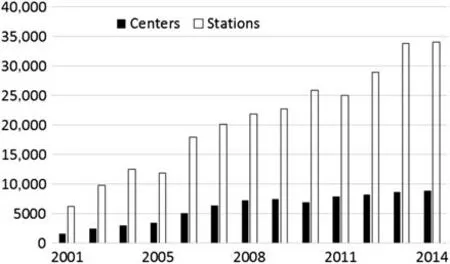
Fig. 1. The number of community health service institutions in China.
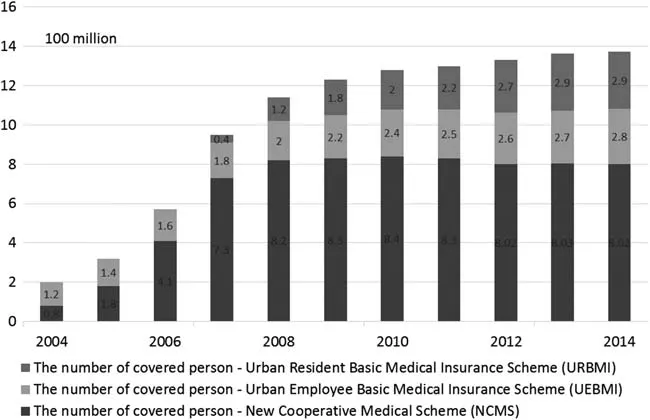
Fig. 2. Universal health insurance coverage in China.
The present study focuses on Hangzhou, a Chinese city with a population of nine million urban and rural residents, to examine the successful development and innovation experience of its primary health care service system during the new health reform in China since 2009 and then disseminate the findings through international third parties. The spreading of the development pattern of Hangzhou will facilitate the progress of health care workers' careers in Hangzhou, as well as advance the health development pattern of Hangzhou's primary health care system. We used measures such as data analysis, study of documents and regulations, fieldwork,and expert discussions to systematically investigate primary health care in Hangzhou. The findings will have a profound practical impact on the health reform for nine million rural and urban residents throughout Hangzhou's municipal boroughs.
Development and characteristics of community health services in Hangzhou
Basic information and medical resources for Hangzhou
Hangzhou, located in the northern part of China's southeast coast, is the capital of Zhejiang province. Hangzhou has long been an important region for China's development and the opening up of China's southeast coast. Hangzhou's scenery makes it one of the most famous tourist cities in China.The high level of industrialization, including its advanced manufacturing, high technology, and businesses center for Alibaba and other e-commerce companies, makes Hangzhou a case study. Hangzhou also has a thriving service industry and is a national example of how to properly develop a tourism industry that attracts millions of Chinese tourists and visitors from around the world. As a leading example of a prosperous city, Hangzhou attracts migrant workers from all over China and international workers. According to the "China Headquarters Economic Development Report(2013–2014)," Hangzhou has been ranked as fifth nationwide in a comparison with other cities in China in terms of fundamental conditions, business facilities, research and development capabilities, and professional services and government services.
Hangzhou's municipal city consists of 14 districts, sub cities and counties, which are Shangcheng district, Xiacheng district, Xiaoshan district, Jianggan district, Gongshu district,West Lake district, Xiasha district, Bingjiang district, Yuhang district, the recently added Fuyan district, the two countylevel cities Jiande and Lin'an, and the two counties Tonglu and Chun'an. There are 190 villages and townships (streets), with 23 townships, 82 towns, and 85 streets. Over the last 15 years,Hangzhou has expanded its boundaries through urban development and taken over administration of rural districts. The total area of Hangzhou is 16,596 km2, similar to the size of the US state of Hawaii. The socioeconomic level of Hangzhou is comparable to the that of upper-middle-income countries. The gross domestic product (GDP) of Hangzhou is 834.35 billion yuan and the GDPper capitais $15,220. The total number of permanent residents in Hangzhou is 8.89 million, and the proportion of residents living in urban Hangzhou is 75% (Table 1)[9]. In Zhejiang province, the urban rate is 65%, and the rate in China is nearly 55% [10].
Along with economic development, citizens of Hangzhou live longer and require more health services. In Hangzhou, 19%of local residents are aged 60 years or older. The Hangzhou government understands that if it wants to tackle this issue, it needs more medical and health resources and must continue to reform its primary health care system to meet the growing demand.As demonstrated in Fig. 3, the average numbers of physicians,nurses, and hospital bedsper10,000 inhabitants in Hangzhou are higher than those in Zhejiang and China. However, the numbers of nurses in Hangzhou, Zhejiang, and China are all considerably compared with those in Western countries when the OECD health care average level and the American health care level in 2012 are used as the reference [11].
Starting in 2003, Hangzhou began investing heavily in its health care system through reform. The reform has the aim that"slight illness is treated in the community and serious illnesses have a guarantee," and the development of community health services in Hangzhou was continuously improved. According to the Hangzhou Health and Family Planning Commission,community health centers covered 100% of neighborhoods and 94.9% of the population of Hangzhou by the end of 2013. Each center can be reached within 15 min by residents in urban areas and within 20 min by residents in rural areas by foot. Hangzhou has about five times as many community health centersper10,000 residents as China (Fig. 4), indicating Hangzhou's commitment to providing primary heath care in the community.

Table 1. Populations of China, Zhejiang, and Hangzhou in 2014
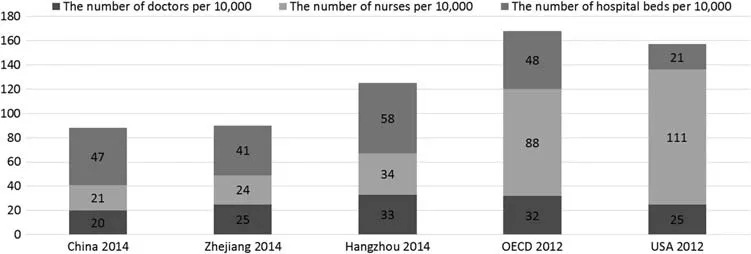
Fig. 3. Comparison of medical and health resources.
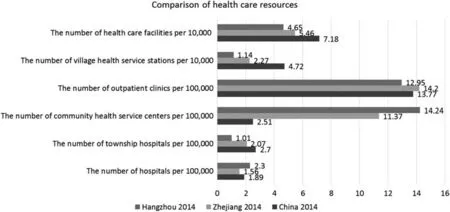
Fig. 4. Comparison of medical and health care resources.
Characteristics of community health services in Hangzhou
Hangzhou has historically been a city at the forefront of developing its community health service [12]. Most of China's health care reform programs had been accomplished well in Hangzhou in the previous two decades before they were functioning nationally and in other provinces. The three significant items of the new health care reform are as follows:
(1) Universal health coverage through the UEBMI, URBMI,and NRCMCS.
(2) The establishment of a community health service system has been implemented. Promotion and administration to separate revenue and expenditure has been achieved.
(3) The capability of public health services has been strengthened, and Hangzhou is recognized as a hygienic city at the state level.
We have characterized the community health services in Hangzhou as follows: (1) they are government led, with the government playing the central role in community health services; (2) they are guaranteed with enough financing, medical personnel, facilities, and regulations by the government; (3)they are supported by an integrated information platform; (4)GPs have been assigned the central role of health gatekeepers;(5) primary health care has been combined with basic public health services; (6) there are integrated urban and rural health services and insurance coverage; and (7) there is health care–pension–nursing integration and GP-contracted 'smart'services.
Government led
The municipal government conducted special studies and site investigations of community health services. Hangzhou's government issued a series of documents (Table 2) and activelyimproved the supporting policies and plays the leading role in its health care reform to develop a comprehensive primary care system.

Table 2. Policies issued by the Hangzhou government
Guaranteed mechanism
The government leaders understood that there must be guarantees for the system to reduce health care spending growth and make the community health service system more financially sustainable. They decided to have enough financing, personnel, facilities, and regulations for the community health service system to be able to provide good health services. The municipal government set up a special fund for community health service financing guarantees with spending of 10 million yuan each year. The spending was increased to 20 million yuan in 2007 for facility renovations and establishment of the municipal community information service. To guarantee the medical personnel for community health services, Hangzhou's municipal government released "Opinions on Improving the Team Establishment of Community Health Service Institutions in the City," and stated that community health service centers (stations) should be developed with 12–16 medical service staff for every 10,000 population. These medical workers for the community health service centers (stations) will be government employees. The municipal government is responsible for providing the facilities without any rental fees or providing full funding to rent space for community health services. As the regulation guarantee, city government leaders decided that all community health service institutions must be included in health insurance schemes and one of the two designated medical institutions for providing outpatient services must be a community health service institution.
Supported by a unif ed information platform
The unified information platform support for community health services in Hangzhou includes a "One Card" for universal use (the citizen card), "One Professional Network"as Hangzhou's health website, "Two Databases" for storing residents' electronic health records and electronic medical records, "Two Health Information Platforms" at the city and district levels, and "Seven Applications" in community health services, hospitals, government, public health services,emergency command, health decisions, and health service information.
Hangzhou began to use the citizen card as the exclusive identification for health services in 2009, covering 13 districts and counties and 187 health institutions, including village grassroots health service stations, community health service centers, specialized institutions, and large hospitals. Currently,residents can seek treatment in any hospital in Hangzhou, and their health and medical information follows them when they use their citizen card. Hangzhou has also issued the "Health Card in Hangzhou for Zhejiang," which can be used in the entire province and can be used at hospitals at different levels, and this card allows residents who are not permanent residents and do not have a Hangzhou citizen card to access health services.
The citizen card incorporates functions such as information recording, identification, electronic certificates, information search, e-payment, and other important social services.Additionally, the citizen card can be used by residents to submit government applications and social security programs,and even as an e-wallet. Patients are able to use the citizen card to see a physician and have a smart service by using selfservice machines throughout the city. Furthermore, patients can recharge their citizen card account by using cash, bank transfer, and self-service machines.
The assigned central role of GPs as health gatekeepers
Zhejiang General Practice Education and Training Center in Hangzhou was set up in November 1999. This educationtraining center allowed more than 90% of grassroots health workers to acquire knowledge in general practice and achieve the necessary training through multilevel general practice programs. As a result of more training, the development of community general practice in Zhejiang province took off.Multilevel general practice education and training programs include standardized full-time training of GPs, standardized training of GPs in service, GP job training (job transfer), general practice knowledge training of rural physicians,community nurse training, GP team training, general practice continuing education, and training of general practice trainers.
Beginning in 2009, Zhejiang Medical College undertook the task of training community physicians in Hangzhou's rural areas. The rural-orientated students signed employment agreements before starting their studies. After a 3-year period of studying and practice, students are assigned to a rural health institution or a community hospital by the human resources and health departments. During this time, Hangzhou's city government provides a 50% subsidy for college fees for each student who has taken part in the GP training, and the other 50% is paid by the district, county, or city health bureau where the student will work.
From 2010 to the present, Hangzhou has established a '5+3' standardized training system for GPs, which was set up by the State Council. The 5+3 training program was developed to improve clinical medical continuing education,standardized management training, examination, and registration, teacher training, and establishment of training bases.In Hangzhou there are currently 25 standardized GP training bases (seven provincial, three municipal, and 14 at the district level), and the capacity for training is 56 GPs and 450 assistant GPs each year. By the end of 2013, 3640 physicians had been trained and qualified as a GP, and 2878 were registered as GPs in Hangzhou (about four GPsper10,000 residents).
"Make an appointment for diagnosis and seek treatment in the community" is a slogan in Hangzhou for residents to seek medical and health services in community outpatient centers. When patients are seeking health care for the first time, community physicians decide whether a further examination or treatment by physicians at a higher level is necessary.Community-level physicians can also assist patients to make an appointment and refer them to a specialist. Patients are thus able to seek treatment with proper information. "Make an appointment for diagnosis and seek treatment in the community" enables GPs in community health service institutions to assume more responsibilities as the health gatekeepers for patients. Further development of this goal can strengthen the mechanisms of first contact in the community and a two-way referral system.
The contracted services provided by GPs has been fully implemented since 2012 in Hangzhou rural and urban areas with the model of 'community health management services.'All of the health care costs and pension care costs resulting from the contracted service institutions can be included in the health insurance reimbursement scheme according to the corresponding payment proportion. Hangzhou issued the "Regulations for the Management for Noncommunicable Chronic Diseases by the Chief Physician" in 2013. This regulation requires that specialists in large hospitals provide training, study, communication, diagnosis, and treatment in communities, assist in the capability and improve the services of community health care.Hangzhou further promoted the contracted services of health care–pension–nursing integration by GPs in 2014.
Primary health care combined with basic public health services
The funding of community public health services that is allocated to community health service centers, service stations,and village clinics has been gradually increased to 35–45 yuanper capitaeach year by the Hangzhou government. The special funds are used to support community health service institutions in providing residents with basic public health services for free. The basic public health services under this program include management of health records for both urban and rural residents, health education, vaccination, health management of children from birth to 6 years old, health management of pregnant women, health management of the elderly, health management of patients with hypertension, diabetes, or severe mental disorders, handling of reports of infectious diseases and emergency public health events, and health supervision and management services.
In June 2014, Hangzhou had 7.55 million standardized health records (a rate of 90%), 1.29 million health records for elderly residents, 390,000 health records for pregnant women,340,000 health records for children, and health records for 630,000 patients with hypertension, 30,444 patients with severe mental disorders, and 153,283 patients with diabetes.Hangzhou also established comprehensive demonstration areas for prevention and control of noncommunicable chronic diseases.
Integrated urban and rural health services and insurance coverage
The social insurance funds in China mainly include five categories – namely, a basic pension insurance fund, a basic medical insurance fund, a workers' injury insurance fund,an unemployment insurance fund, and a maternity insurance fund. The basic medical insurance fund includes the UEBMI,URBMI, NRCMCS, and Medical Assistance. Hangzhou has integrated the management resources of medical insurance,and the Labor Security Department has unified the basic health insurance system in Hangzhou, including the UEBMI,URBMI, NRCMCS, and Medical Assistance. As shown in Table 3, the coverage of basic medical insurance for rural residents, the NRCMCS, was gradually expanded and ungraded,and the NRCMCS was merged with URBMI in Hangzhou in 2011 [13]. Hangzhou has been at the forefront nationally in some aspects, such as, the participation rate in the NRCMCS,and the maximum limit of insurance payment. The practice of building up the 'pro-poor hospitals' is known as the'Hangzhou model' and it is applied in Zhejiang province as well as the whole country.
In the new round of health care reforms, management of new rural cooperative medicine has been included in the grassroots health care security system. In 2010, Hangzhou was the first city to have mutual recognition and mutual use of the medical insurance card in urban areas and various suburbs and counties. In 2011, it was rolled out to the whole province,as shown in Table 3.
At present, the sources of the social insurance funds in China can be broadly divided into four kinds: (1) from the insured person according to the percentage of premiums paid through wages; (2) an insurance premium paid by employers as a certain percentage of the total amount of the employee's wages; (3) government financial subsidies to the social insurance fund; (4) social insurance fund from bank interest or investment returns and public donations. In the residents'health care expenses, the ratio of one's own expense is decreasing year by year in China. By the end of 2013, the ratio of outof-pocket spending was 33%, which is higher than in OECD countries (26%).
The medical fee settlements of the health care insurance in Hangzhou carry out total budget management: since 2010,the UEBMI, URBMI, and NRCMCS in Hangzhou have begun the total budget management of fees which are within the scope of basic medical insurance in the medical institutions. The detailed medical fees include ordinary outpatient medical expenses, specific outpatient medical expenses, hospitalization medical expenses, medicine expenses, and other expenses. Every April, according to the final settlement conditions and accommodation coefficient from the previous year, city health care agencies forward the recommendations for the total budget of that year, which will be released after consultation with relevant medical institutions. Every February, the recommendations are annually connected with the actual medical fees, daily management service, and the results of the performance evaluation. Every March, clearing is done.
The operation mechanism of Medical Assistance in Hangzhou
Medical Assistance for severe diseases is managed by the basic health insurance administration service center, which is administrated by the Social Security Department. Since 2008, Hangzhou has begun to implement the "Big Health Care Insurance," which is the result of the merger of the UEBMI, URBMI, and Medical Assistance. The "Big Health Care Insurance" can unify the medical service administration by the Department of Social Security, the Departmentof Human Resources, and the Department of Health, as well as the Department of Civil Affairs, in the insurance administration service center. The insurance administration service center will aim to realize the whole process of insurance as one 'pathway' of outpatient care, hospitalization, and medical assistance for severe diseases. The insurance participants with a citizen card can seek health services and purchase medications in 2000 designated hospitals and pharmacies in Hangzhou, and need to pay only the individual part of the costs. Other medical expenses will be settled by the management service center with the designated medical institutions.

Table 3. Hangzhou medical insurance development.
Medical Assistance for severe diseases mainly insures those insurance participants with severe diseases with high medical expenses who are personally burdened after the URBMI and NRCMCS. In addition, Medical Assistance for severe diseases works to avoid families' catastrophic health expenditures for urban and rural residents as the goal and reasonably determine the insurance compensation policy for severe diseases, with the actual payment proportion not being more than 50%. According to the medical expenses and the proportion of the subpayment, the higher the medical expense, the higher the payment proportion of medical expense in principle.
The settlement scheme of smarter health care by the citizen card in Hangzhou
Hangzhou performs the settlement during the medical visit,which means the patient pays during the process of diagnosis and treatment. This settlement scheme is a further improvement on the basis of 'diagnosis and treatment first and pay later' implemented by the former Ministry of Health. Patients are able to swipe their citizen card once and their medical costs are deducted by 'a card' and 'two settlements,' one settlement from the medical insurance account and another for the self-paying portion of the personal fund.
The outstanding features of this settlement scheme are as follows: (1) it realizes information sharing as the balance on the citizen card account can generally be used in hospitals with the smarter health care program, and the balance on the citizen card account can be used in certain shops for payment by card;(2) if the citizen card is lost, patients can have a replacement card; (3) the Hangzhou citizen card and the medical insurance card can be rolled into one card to combine the two functions of payment and health insurance. Patients need carry only a citizen card for medical visits.
Health care–pension–nursing integration and GP-contracted smart services
Health care–pension–nursing integrated smart services refers to an accessible, continuous, comprehensive, effective,personalized new service model utilizing information technology, integrating resources, expanding day-care and institutional pension services, and relying on community workers and the home. Health care–pension–nursing integration and GP-contracted smart services are based on health care–pension–nursing service platforms, including information technology, contracted services of GPs as health gatekeepers,first diagnosis in the community, graded treatment, two-way referral, multisite licensing of physicians, and health integration of counties and villages. Provision of door-to-door health services by GPs is also part of the health care–pension–nursing integration in Hangzhou and involves some personal and multilevel services such as health management, community health care, a two-way referral system, a family ward, and health evaluation. Residents in Hangzhou can selectively sign a contract in their designated community health service institutions on their own.
The main urban areas in Hangzhou have expanded the health care–pension–nursing integration since October 2014.Currently there are 560,000 signed-up residents. Elderly residents and patients with noncommunicable chronic diseases account for more than 50%. The number of GPs contracted is 817,992 for assistant GPs, and 503 for GP service teams. The fee for the health care–pension–nursing integrated service,120 yuanperyear, is underwritten by the city and county governments. The personal portion of the payment is 10%,which is 12 yuan. The only obligation of signed-up residents is to make sure that the first diagnosis is within the community. The contracted services are led and supported by medical insurance policies. After the resident has signed up,the payment for the first and second levels of the URBMI will be deducted that year. It is important that most of the signing-up fees are fed back to the contracted physicians as compensation.
The health status of residents in Hangzhou Comparison of the health status in Hangzhou,Zhejiang, China, and OECD countriesAs health care spending is an important issue, we investigated GDPper capitain order to compare the health status of residents in Hangzhou, Zhejiang, China, and OECD countries. As shown in Fig. 5, OECD GDPper capitais about 60% higher than in Hangzhou and three times higher than in China. The OECD total expenditure on health,per capita, is much higher than in Hangzhou, Zhejiang, and China (Fig. 6), indicating that there is a gap in total expenditure on health,per capita, between China and Western developed countries.
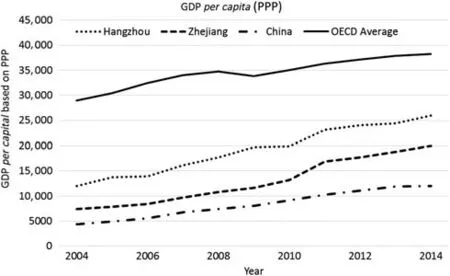
Fig. 5. Comparison of gross domestic product (GDP) per capita in Hangzhou, Zhejiang, China, and OECD countries. PPP, purchasing power parity.

Fig. 6. Comparison of total expenditure on health, per capita, of Hangzhou, Zhejiang, China, and OECD countries.
From Figs. 7 and 8, data from 2004 to 2014 show life expectancy in Hangzhou, Zhejiang, China, and OECD counties is increasing and the mortality rate of infants is decreasing year by year. The mortality rate of pregnant women is mainly declining as well (Fig. 9). In Hangzhou, life expectancy is higher than in China and Zhejiang province, and is comparable to the OECD average level. Furthermore, the mortality rate of infants in Hangzhou is the lowest among the groups and continues to decline. The maternal mortality rate is close to the level in Zhejiang and lower than that in China and OECD countries.

Fig. 7. Comparison of life expectancy in Hangzhou, Zhejiang, China,and OECD countries.

Fig. 8. Comparison of infant mortality rates in Hangzhou, Zhejiang,China, and OECD countries.
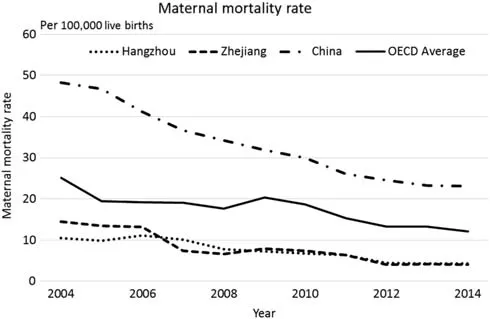
Fig. 9. Comparison of maternal mortality rates in Hangzhou,Zhejiang, China, and OECD countries.
Comparison of the health status among Hangzhou and Xi'anWe also studied the life expectancy, infant mortality rate, and maternal mortality rate of residents of Hangzhou and Xi'an. Hangzhou and Xi'an are representative of cities in eastern and western China, and both cities are provincial capitals and well developed. The life expectancy of residents of Hangzhou is roughly 5 years longer than that of residents of Xi'an (Fig. 10). The infant mortality rate in Hangzhou has trended lower over the last decade and is better than that in Xi'an, which has fluctuated over the same period (Fig. 11). The maternal mortality rate in Hangzhou is noticeably lower than that in Xi'an (Fig. 12).
Further characterization of Chinese community health innovation in the future
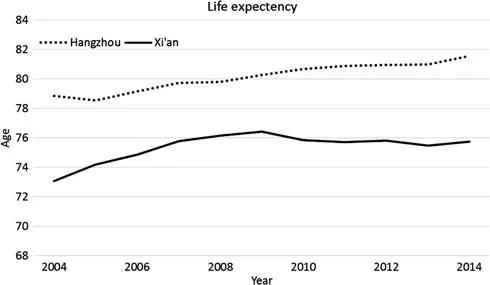
Fig. 10. Comparison of life expectancy in cities in eastern and western China (Hangzhou vs Xi'an).
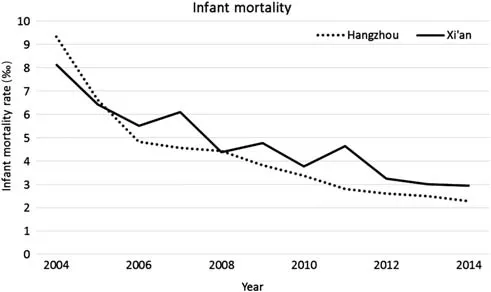
Fig. 11. Comparison of infant mortality rates in cities in eastern and western China (Hangzhou vs Xi'an).
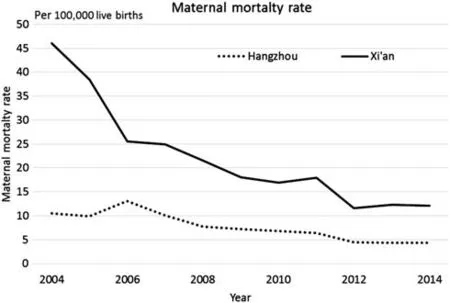
Fig. 12. Comparison of maternal mortality rates in cities in eastern and western China (Hangzhou vs. Xi'an).
To further characterize Chinese community health innovation in the future, we have established academic platforms for cooperation and communication with West Lake International Conference of General Practice, theJournal of Chinese General Practice, Zhejiang University, Zhejiang Provincial Center for Disease Control and Prevention, Hangzhou Health and Family Planning Commission, certain community health service centers (stations) in Hangzhou, and the Stanford Center at Peking University. Our future research programs will include international academic exchanges, publication of academic articles,indexed performance evaluations for the community health services, innovative management of noncommunicable chronic diseases by combining blood lipid and glucose testing, and research,development, and innovation for community health services.
Summary of findings
First, Hangzhou is a city with a long history of developing community health services. Community health services in Hangzhou have been characterized as follows: they are government led; they are guaranteed with enough financing,personnel, facilities, and regulation; they are supported by the unified information platform; GPs are assign the key role of health gatekeepers; they provide primary care combined with basic public health services; there are integrated urban and rural health services and insurance coverage; and there is health care–pension–nursing integration and GP-contracted smart services.
Second, preliminary data collection and analysis has indicated that the basic health status of Hangzhou residents is superior to that of residents of China as a whole, and some health indicators in Hangzhou are comparable to those in Western developed countries, indicating that the primary health care system in China has developed in positive ways during the health care reforms launched in 2009. However,gaps have been noted, especially in medical resources and total expenditure on health,per capita, between China and Western developed countries.
Third, it is reasonable to believe that the primary health care level in China, including Hangzhou, will be further developed and promoted with indexed performance evaluations and more effective implementation of additional measures [14, 15].Further studies are needed to identify what contribution integrated primary care has had and will have on health status,and to demonstrate if good primary care can help to reduce health care spending growth, making a quality health service system more financially sustainable.
Policy implications
In January 2015, Premier Keqiang Li led a State Council executive meeting with the aim of further promoting medical and health care system reforms through strengthening the establishment of rural physician teams [16, 17] and approved the "National Health Service System Planning Outline (2010–2020)." The detailed measures to strengthen the establishment of rural physician teams include no less than one rural physicianper1000 residents, free education and full-time training for rural physicians, further exploring the implementation of the contracted service model for rural residents with regulated fees, expansion of career development for rural physician,and increasing the incomes of rural physicians [18, 19]. The key tasks of the "National Health Service System Planning Outline (2015–2020)" include the graded setting of all public hospitals, further development of private health service institutions, systematic organization of high-quality medical resources, strengthening of the functional organization and cooperation, and acceleration of the reform of public hospitals.
In 2015, China began to promote the longitudinal development of its medical and health system reform. On the basis of the five key tasks of the original medical reform, the new contents embrace the establishment of the first diagnosis in grassroots institutions, implementation of a two-way referral system, separation of treatment of patients with acute and chronic diseases, upper and lower linkage of the graded treatment, building up the personnel training system and salary system, and promotion of the development of health services and accelerated gathering of information on population health.
The important measures to promote community health services in Hangzhou (2015) include the following: (1) service model innovation, such as the health care–pension–nursing integration and GP-contracted smart services; (2) a national and provincial demonstration area for the management of noncommunicable chronic diseases; (3) promotion of traditional Chinese medicine to ensure that the coverage rate of the elderly and young can be more than 30%; (4) introduction of further private capital for medical and health services (the number of beds in private medical institutes must account for about 20%of the total number of beds in the city); (5) establishment and improvement of the national healthy city; (6) implementation of the medical and health care 4-year internationalization action plan (2014–2017) by increasing hospital associations with overseas medical institutions and scientific research associations and academic exchanges in the field of medicine, and setting up international medical collaboration centers and international consultation centers; and (7) discussion and announcement of the future development planning for health services.
Policy challenges
The Chinese government aims to resolve the problems in medical reform by studying the international experience and using measures with Chinese characteristics to overcome the challenging issues. However, insufficient medical and health care resources, poor-quality, unreasonable organization, a fractional system, and the exceptional expansion of public hospitals are obvious problems. By 2020, the population of China is estimated to reach 1.41 billion people, which will instigate conflicts between fewer medical resources and more demands for medical services. The rapid economic development of China offers a firm financial guarantee for the development of medical and health care careers. But at present, economic growth is slowing. The rapid change of lifestyles makes noncommunicable chronic diseases a main burden. Although the health insurance system is improving, patients still need more extensive coverage. With the deepening of medical reform,more and larger public hospitals and improvement in resource allocation are needed. The rapid development of cloud computing, the Internet of things, mobile health applications, and big data can optimize the process of health care and improve service efficiency, which is bound to promote the profound transformation of health care services and the management model.
Acknowledgment
The authors thank Karen N. Eggleston at Walter H. Shorenstein Asia-Pacific Research Center, Stanford University, for her guidance and support of the present studies.
Conflict of interest
The authors declare no conflict of interest.
Funding
This research received no specific grant from any funding agency in the public, commercial, or not-for-profit sectors.
About the author
Feng Lin is a corporate affiliate visiting fellow at the Shorenstein Asia-Pacific Research Center at Stanford University for 2014–2015. He is the founder and chairman of ACON Biotechnology Group, which is credited with building the first good manufacturing practice in vitro diagnostic device facility and first US FDA in vitro diagnostic device registered facility in China. He has also invested in leading clinical laboratories in China and a leading life sciences and drug discovery company in the United States. While at Stanford University, he is studying the innovations in China's primary health care reform. He holds a master's degree in chemical engineering from Oklahoma State University.
1. Jackson T. Prosperity without growth: economics for a finite planet. London: Routledge; 2011.
2. Zambrano E. An axiomatization of the human development index. Soc Choice Welfare 2014;42(4):853–72.
3. Cheng ST, Lum T, Lam LC, Fung HH. Hong Kong: embracing a fast aging society with limited welfare. Gerontologist 2013;53(4):527–33.
4. Ignatavicius DD, Workman ML. Medical-surgical nursing:patient-centered collaborative care. 8th ed. St Louis: Elsevier Health Sciences; 2015.
5. Enthoven AC. Theory and practice of managed competition in health care finance. Amsterdam: Elsevier; 1988.
6. Blumenthal D, Hsiao W. Lessons from the East – China's rapidly evolving health care system. N Engl J Med 2015;372(14):1281–5.
7. Yang Q, Dong HJ. A response to the commentary entitled:Addressing the shortage of health professionals in rural China:issues and progress. Int J Health Policy Manag 2015;4(5):329–30.
8. Huang MF, Wei DH, Rubino L, Wang LS, Li DZ, Ding BF, et al."Three essential elements" of the primary health care system:a comparison between California in the US and Guangdong in China. Fam Med Community Health 2015;3(1):23–9.
9. Fisher EB, Coufal MM, Parada H, Robinette JB, Tang PY,Urlaub DM, et al. Peer support in health care and prevention:Cultural, organizational, and dissemination issues. Annu Rev Public Health 2014;35:363–83.
10. Wang XL, Wan GH. China's urban employment and urbanization rate: a re-estimation. China World Econ 2014;22(1):30–44.
11. Colombo F, Llena-Nozal A, Mercier J, Tjadens F. OECD health policy studies help wanted? Providing and paying for long-term care. OECD Publishing, 2011.
12. Sun H, Qian DF, Du H, Cai WW. Comparative study on health service system and its internal collaboration in abroad. Acta Universitatis Medicinalis Nanjing 2014;2014(1):26–9.
13. Shi S-J. Towards inclusive social citizenship? Rethinking China's social security in the trend towards urban–rural harmonisation. J Soc Policy 2012:41(04).
14. Brusamento S, Legido-Quigley H, Panteli D, Turk E, Knai C,Saliba V, et al. Assessing the effectiveness of strategies to implement clinical guidelines for the management of chronic diseases at primary care level in EU Member States: a systematic review. Health Policy 2012;107(2–3):168–83.
15. Houle SK, McAlister FA, Jackevicius CA, Chuck AW, Tsuyuki RT. Does performance-based remuneration for individual health care practitioners affect patient care?: A systematic review. Ann Intern Med 2012;157(12):889–99.
16. Frenk J, Chen L, Bhutta ZA, Cohen J, Crisp N, Evans T, et al.Health professionals for a new century: transforming education to strengthen health systems in an interdependent world. Rev Peru Med Exp Salud Publica 2011;28(2):337–41.
17. Martin JC, Avant RF, Bowman MA, Bucholtz JR, Dickinson JR,Evans KL, et al. The future of family medicine: a collaborative project of the family medicine community. Ann Fam Med 2004;2 Suppl 1:S3–32.
18. Dussault G, Franceschini MC. Not enough there, too many here:understanding geographical imbalances in the distribution of the health workforce. Hum Resour Health 2006;4:12.
19. Kolstad JR. How to make rural jobs more attractive to health workers. Findings from a discrete choice experiment in Tanzania.Health Econ 2011;20(2):196–211.
Feng Lin ACON Primary Care Research Center, 4F Tower B, Union Plaza, No.2 Zijinghua Road,Hangzhou, Zhejiang 310023,China
E-mail: feng.lin8@yahoo.com
22 June 2015;
Accepted 26 August 2015
 Family Medicine and Community Health2015年3期
Family Medicine and Community Health2015年3期
- Family Medicine and Community Health的其它文章
- Primary health care, a concept to be fully understood and implemented in current China's health care reform
- Survival in men older than 75 years with low- and intermediate-grade prostate cancer managed with watchful waiting with active surveillance
- Primary care clinicians' strategies to overcome f nancial barriers to specialty health care for uninsured patients
- Disconnect between primary care and cancer follow-up care:An exploratory study from Odisha, India
- Stool DNA-based versus colonoscopy-based colorectal cancer screening: Patient perceptions and preferences
- Overview
